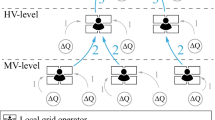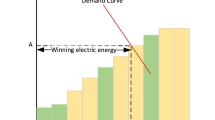Abstract
In this paper, a new clearing method for the separate reactive power market aiming at improving the reactive power compensation quality is presented. To analyze the performance of the proposed clearing method, indices including profitability rates for power suppliers, participation rates of power suppliers and fair distribution of the revenue and net surpluses have been developed. Robustness and efficiency of the proposed clearing method are tested on the 24-bus IEEE RTS system, and the market problem is solved by a multi-objective evolutionary algorithm based on decomposition. The results evidence that the proposed clearing method improves the quality of reactive power compensation if compared with the available market clearing methods.




Similar content being viewed by others
Abbreviations
- \( i,j \) :
-
Bus number
- \( u \) :
-
Unit number
- \( N_{\text{B}} \) :
-
Total number of system buses
- \( {\text{NU}}_{i} \) :
-
Total number of generating units connected to bus \( i \)
- \( Q_{{{\text{G}}_{\rm min} }}^{i,u} \) :
-
Minimum reactive power generation of bus \( i \), unit \( u \)
- \( Q_{{{\text{G}}_{\rm max} }}^{i,u} \) :
-
Maximum reactive power generation of bus \( i \), unit \( u \)
- \( Q_{{{\text{D}}\, i}} \) :
-
Total reactive demand of bus \( i \)
- \( P_{{{\text{D}}\, i}} \) :
-
Total active demand of bus \( i \)
- \( Y_{i,j} \) :
-
Line admittance magnitude between bus \( i \) and \( j \)
- \( \theta_{ij} \) :
-
Line admittance angle between bus \( i \) and \( j \)
- \( C_{0}^{i,u} \) :
-
MCP of bus \( i \) unit \( u \) for unit availability \( \left( {{{\$ /}}\left( {{\text{MVar}}\;{\rm h}} \right)} \right) \)
- \( C_{1}^{i,u} \) :
-
MCP of bus \( i \), unit u for reactive power absorption in zone \( \left( {Q_{\rm min} , 0} \right) \)\( \left( {{{\$ /}}\left( {{\text{MVar}}\;{\rm h}} \right)} \right) \)
- \( C_{2}^{i,u} \) :
-
MCP of bus \( i \), unit \( u \) for reactive power generation in zone \( \left( {Q_{\text{base}} , Q_{A} } \right) \)\( \left( {{{\$ /}}\left( {{\text{MVar}}\;{\rm h}} \right)} \right) \)
- \( C_{3}^{i,u} \) :
-
MCP of bus \( i \), unit \( u \) for reactive power generation in zone \( \left({Q_{A}, Q_{B} } \right)\left({{{\$/}}\left({{\text{MVar}}\,{\text{h}}} \right)\hat{}2 } \right) \)
- \( a_{0}^{i,u} \) :
-
Proposed availability price for bus \( i \) unit u\( \left( {{{\$ /}}\left( {{\text{MVar}}\;{\rm h}} \right)} \right) \)
- \( M_{1}^{i,u} \) :
-
Proposed price of unit \( u \) connected to bus \( i \) for zone \( \left( {Q_{\rm min} , 0} \right) \left( {{{\$ /}}\left( {{\text{MVar}}\;{\rm h}} \right)} \right) \)
- \( M_{2}^{i,u} \) :
-
Proposed price of unit \( u \) connected to bus \( i \) for zone \( \left( {Q_{\text{base}} , Q_{A} } \right) \)\( \left( {{{\$ /}}\left( {{\text{MVar}}\;{\rm h}} \right)} \right) \)
- \( M_{3}^{i,u} \) :
-
Proposed price of unit \( u \) connected to bus \( i \) for zone \( \left({Q_{A}, Q_{B}} \right) \,\left({{{\$/}}\left({{\text{MVar}}\;{\text{h}}} \right)\hat{}2 } \right) \)
- \( Q_{{{\text{av}},{\text{G}}_{\rm max} }}^{i,u} \) :
-
Maximum reactive power available for unit \( u \) connected to bus \( i \)
- \( Q_{{{\text{av}},{\text{G}}_{\rm min} }}^{i,u} \) :
-
Minimum reactive power available for unit \( u \) connected to bus \( i \)
- \( Q_{\text{base}} \) :
-
Generated reactive power required for its auxiliary equipment
- \( Q_{A} \) & \( Q_{B} \) :
-
The maximum allowable reactive power limit with a reduction in real power generation
- \( \beta \) :
-
The selection pressure in Boltzmann for Pareto selection
- \( H \) :
-
The difference of \( {\text{MaxInd}} \) and \( {\text{MinInd}} \) considering appended weighting factors for each index
- \( Q_{{1{\text{G}}}}^{i,u} \) :
-
Reactive power absorption of bus \( i \), unit u for zone \( \left( {Q_{\rm min} , 0} \right) \)
- \( Q_{{2{\text{G}}}}^{i,u} \) :
-
Reactive power generation of bus \( i \), unit \( u \) for zone \( \left( {Q_{\text{base}} , Q_{A} } \right) \)
- \( Q_{{3{\text{G}}}}^{i,u} \) :
-
Reactive power generation of bus \( i \), unit \( u \) for zone \( \left( {Q_{A} , Q_{B} } \right) \)
- \( S_{i,j} \) :
-
Line transmitted power between bus \( i \) and \( j \)
- \( \delta_{i} \) :
-
Voltage angle of bus \( i \)
- \( V_{i} \) :
-
Voltage magnitude of bus \( i \)
- \( P_{\text{G}}^{i,u} \) :
-
Active power injection of bus \( i \), unit \( u \)
- \( X_{0}^{i,u} \) :
-
MCP variable of bus \( i \) unit \( u \) for unit availability \( \left( {{{\$ /}}\left( {{\text{MVar}}\;{\text{h}}} \right)} \right) \)
- \( X_{1}^{{i,{u}}} \) :
-
MCP variable of bus \( i \), unit u for reactive power absorption in zone \( \left( {Q_{\rm min} , 0} \right) \)\( \left( {{{\$ /}}\left( {{\text{MVar}}\;{\text{h}}} \right)} \right) \)
- \( X_{2}^{i,u} \) :
-
MCP variable of bus \( i \), unit \( u \) for reactive power generation in zone \( \left( {Q_{\text{base}} , Q_{A} } \right) \)\( \left( {{{\$ /}}\left( {{\text{MVar}}\;{\text{h}}} \right)} \right) \)
- \( X_{3}^{i,u} \) :
-
MCP variable of bus \( i \), unit \( u \) for reactive power generation in zone \( \left({Q_{A}, Q_{B} } \right)\left({{{\$/}}\left({{\text{MVar}}\;{\text{h}}} \right)\hat{}2 } \right) \)
- \( B_{1}^{i,u} \) :
-
Binary variable of bus \( i \), unit \( u \) for reactive power absorption in zone \( \left( {Q_{\rm min} , 0} \right) \)
- \( B_{2}^{i,u} \) :
-
Binary variable of bus \( i \), unit \( u \) for reactive power generation in zone \( \left( {Q_{\text{base}} , Q_{A} } \right) \)
- \( B_{3}^{i,u} \) :
-
Binary variable of bus \( i \), unit \( u \) for reactive power generation in zone \( \left( {Q_{A} , Q_{B} } \right) \)
- CRLO:
-
Cost rate for lost opportunity
- GSR:
-
Generation sharing rate
- LOC:
-
Lost opportunity cost
- MCP:
-
Market clearing price
- MOEA/D:
-
Multi-objective evolutionary algorithm based on decomposition
- MPR:
-
Market profitability rate
- NGO:
-
Number of generators in the opportunity zone
- NS:
-
Net surplus of power suppliers
- NSS:
-
Power suppliers’ net surplus share
- OZ:
-
Opportunity zone
- PDR:
-
Profit distribution rate
- PPNR:
-
Profitable player number rate
- OF:
-
Objective function
- RWCL:
-
Risk of work in capacity limits
- RPCC:
-
Reactive power compensation costs
- SC:
-
Separate clearing method
- SRPM:
-
Separate reactive power market
- UP:
-
Uniform pricing
- UPR:
-
Units participation rate
References
Shamani M, Ahmadi H, Ramezani M (2017) Probabilistic framework of cooperative disperse generation resources scheme for producing required reactive power through simultaneous active and reactive power markets. CIRED-Open Access Proc J 2017(1):2837–2841
Wang Y, Xu W (2004) An investigation on the reactive power support service needs of power producers. IEEE Trans Power Syst 19(1):586–593
Ahmadi H, Foroud AA (2016) Improvement of the simultaneous active and reactive power markets pricing and structure. IET Gener Transm Distrib 10(1):81–92
Dike DO, Mahajan SM (2015) Voltage stability index-based reactive power compensation scheme. Int J Electr Power Energy Syst 73:734–742
Bhattacharya K, Zhong J (2001) Reactive power as an ancillary service. IEEE Trans Power Syst 16(2):294–300
Zubo RHA, Mokryani G, Abd-Alhameed R (2018) Optimal operation of distribution networks with high penetration of wind and solar power within a joint active and reactive distribution market environment. Appl Energy 220:713–722
Ahmed KS, Karthikeyan SP (2018) Modified penalized quoted cost method for transmission loss allocation including reactive power demand in deregulated electricity market. Sustain Energy Grids Netw 16:370–379
Bracale A et al (2019) Short-term industrial reactive power forecasting. Int J Electr Power Energy Syst 107:177–185
Raha SB, Mandal KK, Chakraborty N (2019) Hybrid SMES based reactive power dispatch by cuckoo search algorithm. IEEE Trans Ind Appl 55(1):907–917
Zhong J, Bhattacharya K (2002) Toward a competitive market for reactive power. IEEE Trans Power Syst 17(4):1206–1215
Ahmadimanesh A, Kalantar M (2017) New structure of reactive power market by considering reactive power losses. Majlesi J Electr Eng 11(2):59–68
Ahmadi H, Foroud AA (2016) Design of joint active and reactive power reserve market: a multi-objective approach using NSGA II. IET Gener Transm Distrib 10(1):31–40
Hernandez JHT, Alcaraz GG, Urcuyo RAS (2015) Linear sensitivities to define reactive power areas for voltage control and reactive power service in electricity markets. IEEE Latin Am Trans 13(1):150–157
Son YS et al (2004) Short-term electricity market auction game analysis: uniform and pay-as-bid pricing. IEEE Trans Power Syst 19(4):1990–1998
Kirschen DS, Strbac G (2005) Fundamentals of power system economics. Wiley, New York
Sahraie E, Marzouni AH, Zakariazadeh A, Gholami M (2018) New reactive power market clearing scheme with controlling the market competitive level. In: 33rd power system conference—22–23 Oct 2018 Tehran, Iran
Sahraie E, Zakariazadeh A, Gholami M (2019) Improvement of demand side management and social welfare index using a flexible market-based approach. IEEE Trans Ind Appl 55(6):7270–7280
Wong P, Albrecht P, Allan R et al (1999) The IEEE reliability test system 1996. IEEE Trans Power Syst 14(3):10101020
Medina MA, Coello CAC, Ramirez JM (2013) Reactive power handling by a multi-objective teaching learning optimizer based on decomposition. IEEE Trans Power Syst 28:3629–3637
Zhang Q, Li H (2007) MOEA/D: a multiobjective evolutionary algorithm based on decomposition. IEEE Trans Evol Comput 11:712–731
Ahmadi H, Akbari Foroud A (2013) A stochastic framework for reactive power procurement market, based on nodal price model. Int J Electr Power Energy Syst 49:104–113
Aarts E, Korst J (1988) Simulated annealing and Boltzmann machines. Wiley, New York
Holland JH (1992) Adaptation in natural and artificial systems: an introductory analysis with applications to biology, control and artificial intelligence. MIT Press, Cambridge
Author information
Authors and Affiliations
Corresponding author
Additional information
Publisher's Note
Springer Nature remains neutral with regard to jurisdictional claims in published maps and institutional affiliations.
Rights and permissions
About this article
Cite this article
Sahraie, E., Hassannejad Marzouni, A., Zakariazadeh, A. et al. Reactive power market clearing mechanism considering new clearing constraints: a separate clearing approach. Electr Eng 102, 1667–1679 (2020). https://doi.org/10.1007/s00202-020-00986-9
Received:
Accepted:
Published:
Issue Date:
DOI: https://doi.org/10.1007/s00202-020-00986-9




